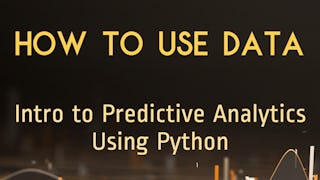This course provides a hands-on journey into credit risk prediction using Python with a focus on logistic regression, decision trees, and ensemble methods. Learners will begin by outlining project workflows, importing data, and applying data preprocessing techniques such as handling missing values, encoding categorical features, and scaling numerical variables. Through exploratory data analysis (EDA), they will interpret data patterns and relationships to build stronger foundations for modeling.
您将学到什么
Preprocess financial datasets using encoding, scaling, and EDA techniques.
Build and tune logistic regression, decision trees, and Random Forest models.
Evaluate credit risk models with confusion matrices, ROC curves, and ensemble methods.
您将获得的技能
- Credit Risk
- Exploratory Data Analysis
- Random Forest Algorithm
- Performance Metric
- Predictive Modeling
- Pandas (Python Package)
- Risk Modeling
- Financial Modeling
- Data Processing
- Predictive Analytics
- Machine Learning Methods
- Decision Tree Learning
- Data Manipulation
- Scikit Learn (Machine Learning Library)
- Supervised Learning
- Data Analysis
- Performance Tuning
- Applied Machine Learning
- Classification And Regression Tree (CART)
- Feature Engineering
要了解的详细信息

添加到您的领英档案
September 2025
6 项作业
了解顶级公司的员工如何掌握热门技能

该课程共有2个模块
In this module, learners gain a strong foundation in building a credit default prediction model using Python. The module introduces the project’s scope, outlines the workflow, and emphasizes the importance of structured data handling. Learners will explore data preprocessing techniques such as handling missing values, encoding categorical features, and scaling numerical variables. In addition, they will perform exploratory data analysis (EDA) to identify patterns, visualize distributions, and uncover key relationships within the dataset. Finally, learners will split the dataset into training and testing sets to ensure reliable evaluation of logistic regression models for predicting credit default risk.
涵盖的内容
9个视频3个作业1个插件
In this module, learners advance beyond data preparation into the core of predictive modeling. The module introduces evaluation metrics such as the confusion matrix and ROC curve to assess classification performance in credit default prediction. Learners will then explore hyperparameter tuning methods like Grid Search and Randomized Search to optimize logistic regression models. The module further builds knowledge with decision tree theory, covering splitting criteria, visualization using Graphviz, and practical implementation in Python. Finally, learners will apply ensemble techniques with Random Forest to reduce overfitting and improve model accuracy for robust credit risk prediction.
涵盖的内容
10个视频3个作业
从 Data Analysis 浏览更多内容
 状态:免费试用
状态:免费试用University of Pennsylvania
 状态:预览
状态:预览Starweaver
 状态:免费试用
状态:免费试用Edureka
 状态:免费
状态:免费Coursera Project Network
人们为什么选择 Coursera 来帮助自己实现职业发展




常见问题
To access the course materials, assignments and to earn a Certificate, you will need to purchase the Certificate experience when you enroll in a course. You can try a Free Trial instead, or apply for Financial Aid. The course may offer 'Full Course, No Certificate' instead. This option lets you see all course materials, submit required assessments, and get a final grade. This also means that you will not be able to purchase a Certificate experience.
When you purchase a Certificate you get access to all course materials, including graded assignments. Upon completing the course, your electronic Certificate will be added to your Accomplishments page - from there, you can print your Certificate or add it to your LinkedIn profile.
Yes. In select learning programs, you can apply for financial aid or a scholarship if you can’t afford the enrollment fee. If fin aid or scholarship is available for your learning program selection, you’ll find a link to apply on the description page.
更多问题
提供助学金,




 中
中

